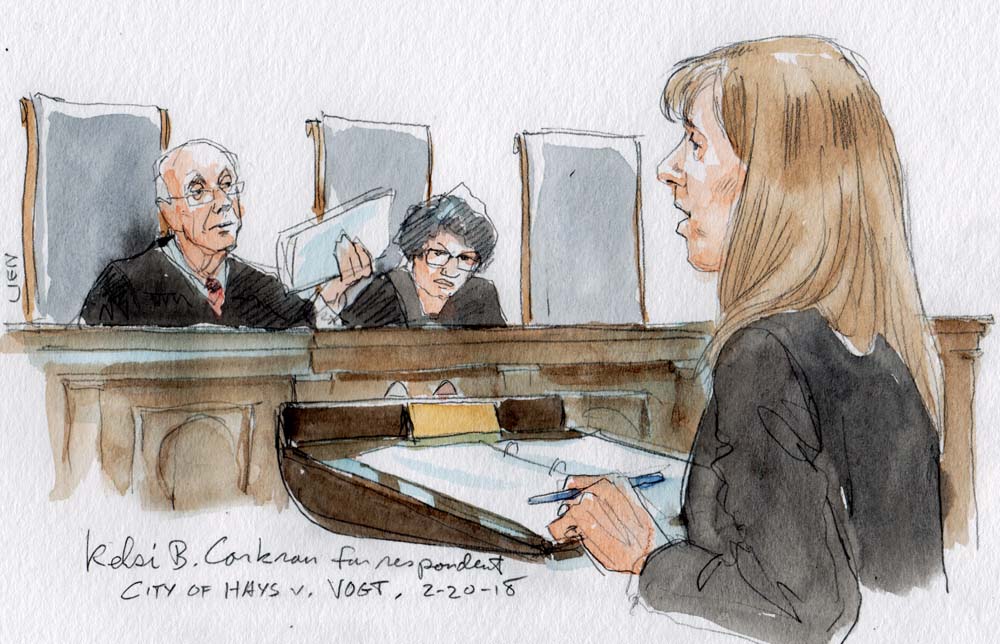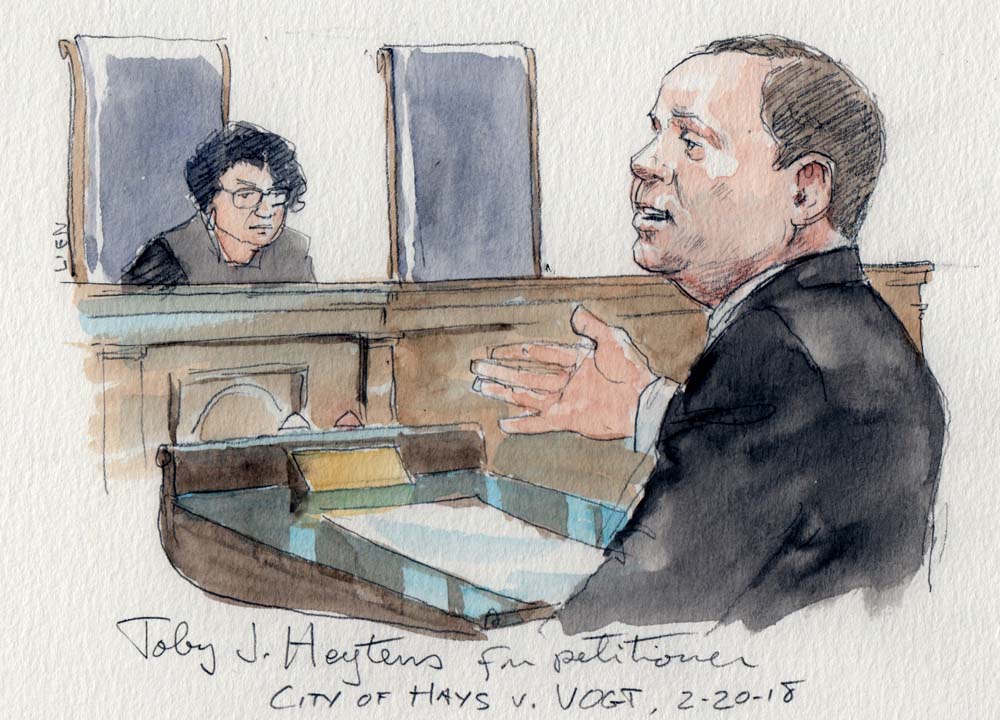Argument analysis: Vogt argument suggests a narrow ruling or even a “DIG”

on Feb 21, 2018 at 11:43 am

My preview of City of Hays, Kansas v. Vogt described the case as “deceptively complex.” Some of the difficulties in the case seem to have come into focus only (as Justice Stephen Breyer candidly put it) “suddenly … for the first time” at yesterday’s oral argument. The Question Presented is whether, in a Section 1983 civil suit for damages, allegations that a defendant was compelled to make incriminating statements that were later used against him in a criminal preliminary hearing (and not at a trial) state a violation of the Fifth Amendment. After exploring some of the complexities (from opposite perspectives), Justices Samuel Alito and Sonia Sotomayor found themselves in agreement: They both perceived the case as “very odd.”
Indeed, halfway through the hour, Breyer suggested that the case now “raises the question whether this is, in fact, an appropriate case … for the Court to take.” Vogt’s attorney embraced the implication: “[I]f the Court wanted to DIG the case … we would certainly not object.” (“DIG” is Supreme Court shorthand for “Dismiss as Improvidently Granted,” simply un-granting the petition for certiorari and dismissing the case without any opinion on the merits.) Although Chief Justice John Roberts appeared to object, telling the attorney that “it’s a question you have been presented with,” the uncertain doctrinal implications of any ruling, along with problems with the record that were recognized at oral argument, could support a “DIG” result here.

Justice Breyer questions respondent’s lawyer, Kelsi B. Corkran (Art Lien)
A “very odd” factual and procedural posture
The facts, as well as the procedural posture, are indeed “odd.” Vogt, an officer with the Hays Police Department, applied to a different police department for a job. The new department offered Vogt the job, but conditioned the offer on Vogt’s reporting to the Hays department that he had kept a knife he’d gained access to as an officer. After Vogt reported the incident, the Hays department directed him to make a more detailed statement or lose his job. That condition (“speak or lose your job”) made Vogt’s further statements “compelled” under a controversial but long-standing 1967 decision called Garrity.
After making these statements, Vogt resigned to take the job with the new police department. But the Hays department referred Vogt’s statements to the state of Kansas for prosecution, and Vogt was charged with a crime related to the knife incident. Meanwhile, the new department withdrew Vogt’s job offer due to the criminal investigation. Vogt then sued the city of Hays, alleging that his statements had been used at a preliminary hearing in the criminal case against him (which was later dismissed), causing damages; and that such use was a reasonably foreseeable consequence of Hays’ having compelled the statements.

Elizabeth B. Prelogar, assistant to the U.S. solicitor general (Art Lien)
These unique facts — a civil case that turns on an odd criminal case history, involving allegations of controversial Garrity compulsion — led Vogt’s lawyer to agree with both Breyer and Roberts that “what happened here is highly unusual.” Moreover, during the argument, the justices appeared to realize that the procedural posture of the case added to their concerns. Vogt’s civil complaint was dismissed by the district court without any factual testing, based on a legal ruling that the Fifth Amendment was not violated because the compelled statements were never used against Vogt at a criminal trial. As is normally the case when a civil complaint is dismissed on a defendant’s motion, the appellate court must assume that all the allegations in the complaint are true.
But here, in materials that are apparently not in the record that was before the lower courts, there is some reason to believe that Vogt’s allegations are not true. When Breyer (and later Alito and Sotomayor) pressed Vogt’s lawyer on those aspects of the case, the chief justice rebuked his colleagues, saying, “I will discount the answers because it is not something that’s in the record.” Still, at least three justices on this eight-justice court (Justice Neil Gorsuch is recused, because this case comes from the U.S. Court of Appeals for the 10th Circuit, his former court) suggested that they had serious misgivings about four important aspects of the case: (1) Was any objection raised to the use of the statements below?; (2) Were Vogt’s statements really “compelled”?; (3) Was there actually any adverse “use” of the statements in the state court hearing below?; and (4) Is there a plausible causation theory that could support Section 1983 damages against the city?
Craft a narrow ruling for Vogt, or just dismiss the case?
Whether these factual and procedural issues are sufficient to DIG the case, or whether the allegations can all be assumed in order to answer, as Roberts put it, the “question you have been presented with,” remains to be seen. However, at least six justices – Roberts and Justices Ruth Bader Ginsburg, Elena Kagan, Alito, Breyer and Sotomayor — also expressed strong misgivings about the merits of the “use” question, exploring various doctrinal problems that a ruling, for either the city or Vogt, might raise. (Justice Anthony Kennedy asked only a few questions, and Justice Clarence Thomas said nothing.) Indeed, counsel for Hays was quickly forced to concede (to his former boss, Ginsburg) that his argument created an “apparent anomaly.” Ginsburg then flatly suggested that a ruling for Hays would “shrink” the Fifth Amendment “to almost a vanishing point,” “because there aren’t many trials nowadays.” Kagan later described Hays’ argument similarly, as “conceptually a difficult position.” In fact, because the perceived constitutional anomalies in this largely unnoticed case arise from the court’s own precedents, it seemed to dawn on Breyer at argument that “this is an important case in more ways than one.” Meanwhile, Alito suggested that an opposite ruling, for Vogt, would be “revolutionary.”

Toby J. Heytens for petitioner (Art Lien)
In addition, Roberts and Kennedy expressed concerns about the Garrity employer-compulsion doctrine. That doctrine has long been controversial, and Hays has suggested narrowing it here, although the question presented does not really appear to raise the issue directly. Meanwhile no one was quite able to discern the impact of a ruling, in either direction, on grand jury proceedings or on “Gerstein hearings,” which are judicial determinations of probable cause for people arrested without a warrant. (Moreover, no one at argument even noted that Gerstein does not, in fact, require a “hearing” – a judicial finding of probable cause based on case documents alone is sufficient to hold a criminal defendant after arrest.)
Conclusion
Thus the justices appear divided on the merits, and the doctrinal consequences of a ruling in any direction seemed unsettled at best during the argument. Factual wrinkles, the interlocutory posture and non-record inferences further complicate the case. Particularly this late in a Supreme Court term that is packed with difficult cases — and with Gorsuch’s recusal making an unsatisfying 4-4 tie at least possible — the justices may not feel that the case is worth more effort. It is true that the justices, and Roberts in particular, do not like to dismiss cases once granted, especially with the small number of cases that the court now takes each year. Perhaps Kagan can steer the court to a narrow ruling for Vogt, limited just to preliminary hearings, as she suggested more than once. But a DIG here also now seems like a genuine possibility.


